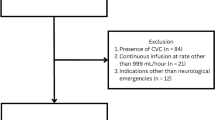Abstract
Background
One of the predictive factors of outcome in traumatic brain injury is high intracranial pressure (ICP). Recently, the time course of ICP has been described but few data are available on the relation of these ICP profiles and outcome. The aim of this study is to investigate the relation of the time course of ICP with CT-findings and outcome.
Methods
Retrospective analysis of prospectively collected data of 246 patients with traumatic brain injury admitted to the neurosurgical intensive care unit.
Results
Early rise in ICP (within the first 2 days) was present in 32%, an intermediate rise (between days 3 and 5) in 34% and a late rise (after day 5) in 34% of patients. Half of the patients with a normal opening pressure (76%) developed intermediate or late ICP rise profiles. More mass lesions and sub/epidural hematomas were present in the late rise group. Patients with a late ICP rise required significant more intensive treatment (65% vs. 37 and 33%) when compared to the early and intermediate rise groups. In multiple regression analysis both ICP profiles and extracranial hematomas were related to outcome. With late ICP rise more unfavorable outcome (46 vs. 17%, P < 0.001) was seen although one in four patients showed a favorable outcome.
Conclusion
During ICP monitoring different ICP profiles are present over time. These profiles are related to CT-characteristics and outcome. The importance of early and late monitoring of ICP is underlined.


Similar content being viewed by others
References
Bullock MR, Povlishock JT. Guidelines for the management of severe traumatic brain injury. J Neurotrauma. 2007;24:S1–90.
Maas AI, Dearden M, Teasdale GM, et al. EBIC-guidelines for management of severe head injury in adults. European Brain Injury Consortium. Acta Neurochir (Wien). 1997;139(4):286–94.
Juul N, Morris GF, Marshall SB, Marshall LF. Intracranial hypertension and cerebral perfusion pressure: influence on neurological deterioration and outcome in severe head injury. The Executive Committee of the International Selfotel Trial. J Neurosurg. 2000;92(1):1–6.
Marmarou A, Anderson RL, Ward JD. Impact of ICP instability and hypotension on outcome in patients with severe head trauma. J Neurosurg. 1991;75:S59–66.
Murray GD, Butcher I, McHugh GS, et al. Multivariable prognostic analysis in traumatic brain injury: results from the IMPACT study. J Neurotrauma. 2007;24(2):329–37.
Miller MT, Pasquale M, Kurek S, et al. Initial head computed tomographic scan characteristics have a linear relationship with initial intracranial pressure after trauma. J Trauma. 2004;56(5):967–72.
Treggiari MM, Schutz N, Yanez ND, Romand JA. Role of intracranial pressure values and patterns in predicting outcome in traumatic brain injury: a systematic review. Neurocrit Care. 2007;6(2):104–12.
Riker RR, Picard JT, Fraser GL. Prospective evaluation of the Sedation-Agitation Scale for adult critically ill patients. Crit Care Med. 1999;27(7):1325–9.
Brain Trauma Foundation, American Association of Neurological Surgeons, Joint Section on Neurotrauma and Critical Care. Guidelines for the management of severe head injury. J Neurotrauma. 1996;13(11):641–734.
Marshall LF, Marshall SB, Klauber MR, et al. The diagnosis of head injury requires a classification based on computed axial tomography. J Neurotrauma. 1992;9(Suppl 1):S287–92.
Maset AL, Marmarou A, Ward JD, et al. Pressure-volume index in head injury. J Neurosurg. 1987;67(6):832–40.
Stocchetti N, Colombo A, Ortolano F, et al. Time course of intracranial hypertension after traumatic brain injury. J Neurotrauma. 2007;24(8):1339–46.
Wilson JT, Pettigrew LE, Teasdale GM. Structured interviews for the Glasgow Outcome Scale and the extended Glasgow Outcome Scale: guidelines for their use. J Neurotrauma. 1998;15(8):573–85.
Maas AI, Stocchetti N, Bullock R. Moderate and severe traumatic brain injury in adults. Lancet Neurol. 2008;7(8):728–41.
O’Phelan KH, Park D, Efird JT, et al. Patterns of increased intracranial pressure after severe traumatic brain injury. Neurocrit Care. 2009;10(3):280–6.
Verweij BH, Muizelaar JP, Vinas FC. Hyperacute measurement of intracranial pressure, cerebral perfusion pressure, jugular venous oxygen saturation, and laser Doppler flowmetry, before and during removal of traumatic acute subdural hematoma. J Neurosurg. 2001;95(4):569–72.
Souter MJ, Andrews PJ, Pereirinha MR, Signorini DF, Jones PA, Miller JD. Delayed intracranial hypertension: relationship to leukocyte count. Crit Care Med. 1999;27(1):177–81.
Unterberg A, Kiening K, Schmiedek P, Lanksch W. Long-term observations of intracranial pressure after severe head injury. The phenomenon of secondary rise of intracranial pressure. Neurosurgery. 1993;32(1):17–23.
Maas AI, Hukkelhoven CW, Marshall LF, Steyerberg EW. Prediction of outcome in traumatic brain injury with computed tomographic characteristics: a comparison between the computed tomographic classification and combinations of computed tomographic predictors. Neurosurgery. 2005;57(6):1173–82.
Venkatesh B, Garrett P, Fraenkel DJ, Purdie D. Indices to quantify changes in intracranial and cerebral perfusion pressure by assessing agreement between hourly and semi-continuous recordings. Intensive Care Med. 2004;30(3):510–3.
Acknowledgments
A. Coers, research nurse, for collecting data of patients and technical assistance and H. Burgerhof for the statistical advice.
Author information
Authors and Affiliations
Corresponding author
Rights and permissions
About this article
Cite this article
Bremmer, R., de Jong, B.M., Wagemakers, M. et al. The Course of Intracranial Pressure in Traumatic Brain Injury: Relation with Outcome and CT-characteristics. Neurocrit Care 12, 362–368 (2010). https://doi.org/10.1007/s12028-009-9329-2
Published:
Issue Date:
DOI: https://doi.org/10.1007/s12028-009-9329-2




